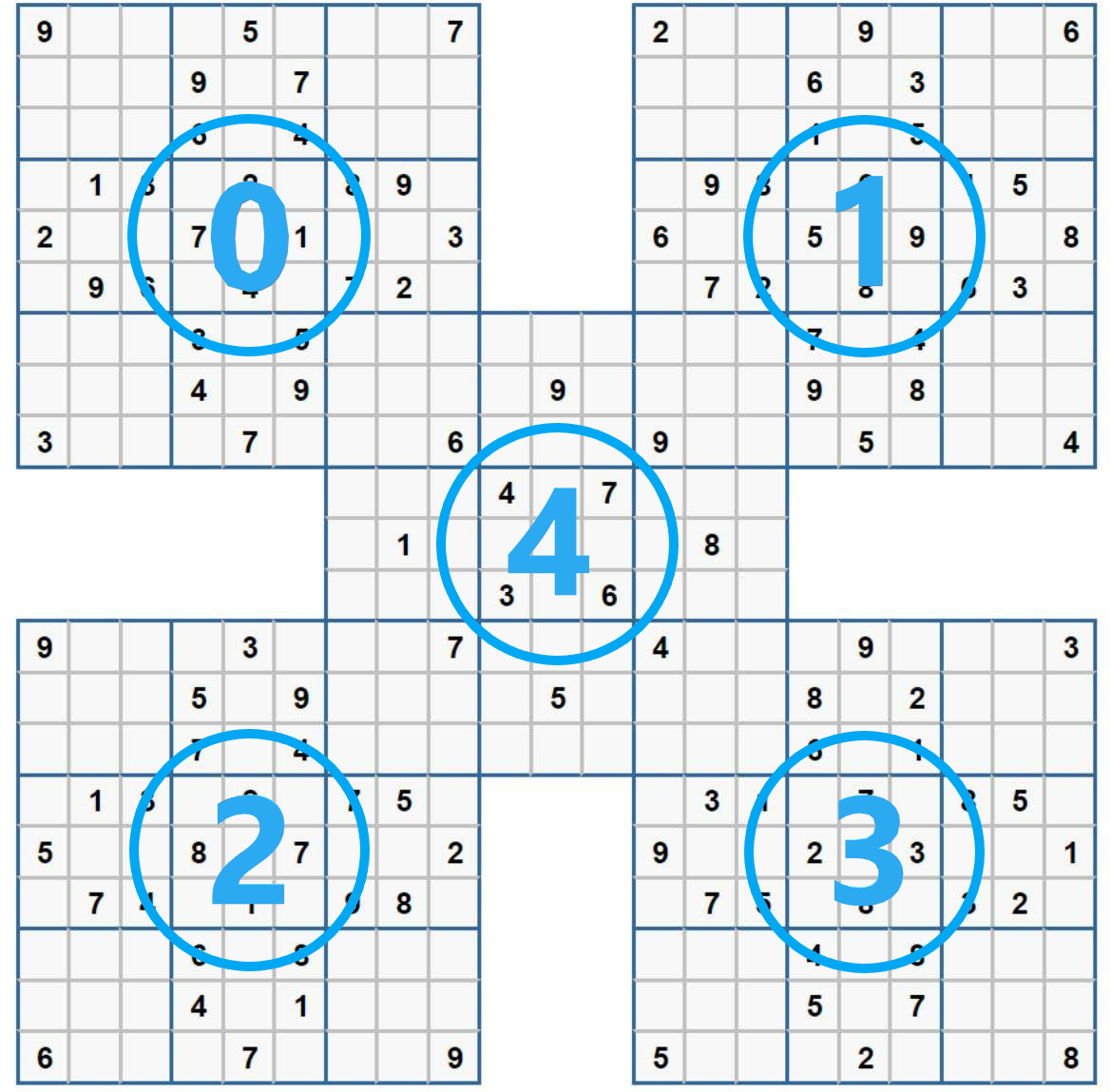Course 6125021 Combinatorics Homework 1,武士数独
数独求解,第一个想到的方法就是DFS回溯。但是简单回溯法在求解单个数独时效率还能接受,放在五重数独(武士数独)上可以就有点差强人意了。我要是用它来解武士数独的话也没必要为这道题写篇博客了 🐱。
开搞
在此之前又仔细学习了一遍DancingLinks。DLX算法解数独的关键在于将数独转化为精确覆盖问题,这一步在单个矩阵的情况下还是比较容易的,但在武士数独上就比较繁琐了。
定义数据结构
1
2
3
4
5
6
7
8
9
10
11
12
13
14
15
16
17
18
19
20
21
22
23
24
25
26
27
28
29
30
31
32
33
34
35
36
37
38
39
40
41
42
43
44
45
|
const static int SAMURAI_EDGE = 21;
const static int SAMURAI_MATRIX = 441;
const static int SAMURAI_ROWS = 405;
const static int SUDOKU_EDGE = 9;
const static int SUDOKU_MATRIX = 81;
const static int COLUMN_SIZE = 1692;
class DLNode
{
public:
DLNode * Left; // 左结点
DLNode *Right; // 右结点
DLNode *Up; // 上结点
DLNode *Down; // 下结点
DLNode *Col; // 所属列结点
int row; // 行号
int nums; // 该列存在的结点个数(当结点为列结点时有效,否则为-1)
DLNode(DLNode *Col, int n, int s = -1):
Left(this), Right(this), Up(this), Down(this),
Col(Col), row(n), nums(s){ if (Col) Col->Add2Colume(this); };
~DLNode() {};
void Add2Row(DLNode *node); // 添加结点到该行末尾
void Add2Colume(DLNode *node); // 添加结点到该列尾
void RemoveCol(); // 移除该结点所在的列
void RecoverCol(); // 还原列
void Remove(); // 移除该结点关联的行和列
};
class DancingLinks
{
public:
DancingLinks(int s[SAMURAI_EDGE][SAMURAI_EDGE]);
~DancingLinks();
DLNode *Head;
std::vector<DLNode *> Cols; // 列向量
std::vector<DLNode *> Ans; // 保存结果
bool DLX(); // DLX算法求解
void ShowResult(int result[SAMURAI_MATRIX]); // 输出结果
};
|
数独规则:
- 每个格子只能填一个数字
- 每行每个数字只能填一遍(1-9)
- 每列每个数字只能填一遍(1-9)
- 每宫每个数字只能填一遍(1-9)
武士数独精确覆盖问题
武士数独有五个数独组成,需要 $21 \times 21$ 大小的矩阵存储数据,即 $441$ 个元素。给五个数独编号
![https://cdn.jsdelivr.net/gh/xxy-im/storage@gh-pages/images/sudoku1.png]() 武士数独编号
武士数独编号
约束定义(索引从0开始)
- 定义441列
第0列:表示位置(0, 0)填了一个数字
第1列:表示位置(0, 1)填了一个数字
. . . . . .
第20列:表示位置(0, 20)填了一个数字
第21列:表示位置(1, 0)填了一个数字
. . . . . .
第440列:表示位置(20, 20)填了一个数字
位置$(X,Y)$, $Col = X \times 21 + Y$
- 定义405列(5个数独,总共45行)
第441列:0号数独的第0行填了数字1
第442列:0号数独的第0行填了数字2
. . . . . .
第449列:0号数独的第0行填了数字9
第450列:0号数独的第1行填了数字1
. . . . . .
第845列:4号数独的第8行填了数字9
第N列定义为 第$S$号数独$X$行填了数字$Y$,它们之间的关系为
$N = 441 + S \times 81 + X \times 9 + (Y-1)$
- 定义405列(5个数独,总共45列)
第846列:0号数独的第0列填了数字1
第847列:0号数独的第0列填了数字2
. . . . . .
第857列:0号数独的第0列填了数字9
第858列:0号数独的第1列填了数字1
. . . . . .
第1250列:4号数独的第8列填了数字9
第N列定义为 第$S$号数独$X$列填了数字$Y$,它们之间的关系为
$N = 441 + 405 + S \times 81 + X \times 9 + (Y-1)$
- 定义441列($21\times21$矩阵,总共49个宫,为方便计算没有删去空白的宫)
第1251列:第0宫填了数字1
第1252列:第0宫填了数字2
. . . . . .
第1259列:第0宫填了数字9
第1260列:第1宫填了数字1
. . . . . .
第1691列:第48宫填了数字9
第N列定义为 第$S$宫填了数字$D$,它们之间的关系为
$N = 441 + 405 + 405 + S \times 9 + (D-1)$
由上1692列完成了对武士数独的精确覆盖问题约束定义
初始化Dancing Links
用上图数独为例,(0, 0) 位置为 9,转换为DancingLinksz中的一行,则第0,449, 857, 1259列为 1 (即存在结点),其余列为 0。
Dancing Links初始化
1
2
3
4
5
6
7
8
9
10
11
12
13
14
15
16
17
18
19
20
21
22
23
24
25
26
27
28
29
30
31
32
33
34
35
36
37
38
39
40
41
42
43
44
45
46
47
48
49
50
51
52
53
54
55
56
57
58
59
60
61
62
63
64
65
66
67
68
69
70
71
72
73
74
75
76
77
|
DancingLinks::DancingLinks(int sam[SAMURAI_EDGE][SAMURAI_EDGE])
{
Head = new DLNode(nullptr, 0);
// 创建列结点 1692个
for (int i = 0; i < COLUMN_SIZE; i++)
{
auto t = new DLNode(nullptr, 0, 0);
Head->Add2Row(t);
Cols.push_back(t);
}
std::vector<DLNode *> Rows; // 保存初始已存在数字的结点
for (int r = 0; r < SAMURAI_EDGE; r++)
{
for (int c = 0; c < SAMURAI_EDGE; c++)
{
for (int d = 0; d < SUDOKU_EDGE; d++)
{
// 计算行数
int row = (r * SAMURAI_EDGE * SUDOKU_EDGE) + (c * SUDOKU_EDGE) + d;
int sq = (c / 3) + ((r / 3) * 7);
int t = VALID_SQUARE[sq];
if (t > 0)
{
auto node = new DLNode(Cols[r * SAMURAI_EDGE + c], row);
for (int i = 0; i < 2; i++)
{
// 判断sq号宫属于第几号数独
int sd = (t > 5 && !i) ? 4 : t-1;
// 当前r,c属于sd号数独的几行几列
//(感觉用数组索引更方便, 一开始我是直接硬算行列,后来在网上看到有人用数组的方式实现)
int sdr = SUDOKU_ROW[sd][r];
int sdc = SUDOKU_COLUMN[sd][c];
// 五个数独 总共45行 1-9数字情况 405列
node->Add2Row(new DLNode(Cols[SAMURAI_MATRIX +
(sd * SUDOKU_MATRIX) +
(sdr * SUDOKU_EDGE) + d], row));
node->Add2Row(new DLNode(Cols[SAMURAI_MATRIX + SAMURAI_ROWS +
(sd * SUDOKU_MATRIX) +
(sdc * SUDOKU_EDGE) + d], row));
if (t < 6) i++;
t -= 5;
}
node->Add2Row(new DLNode(Cols[SAMURAI_MATRIX + SAMURAI_ROWS + SAMURAI_ROWS +
(sq * SUDOKU_EDGE) + d], row));
if (sam[r][c] == (d + 1))
{
Rows.push_back(node);
}
}
}
}
}
for (auto col = Head->Right; col != Head; col = col->Right)
{
if (!col->nums) col->RemoveCol();
}
for (auto iter = Rows.begin(); iter != Rows.end(); iter++)
{
(*iter)->Remove();
Ans.push_back(*iter);
}
}
|
算法执行过程
1
2
3
4
5
6
7
8
9
10
11
12
13
14
15
16
17
18
19
20
21
22
23
24
25
26
27
28
29
30
31
32
33
34
35
36
37
38
39
40
41
42
43
44
45
46
47
48
49
50
51
52
|
bool DancingLinks::DLX()
{
if (Head->Right == Head)
{
auto result = new int[Ans.size()];
for (int i = 0; i < Ans.size(); i++)
{
result[i] = Ans[i]->row;
}
ShowResult(result);
return true;
}
DLNode *col = nullptr;
int min = INT_MAX;
// 找到列元素最少的列
for (auto c = Head->Right; c != Head; c = c->Right)
{
if (min > c->nums)
{
col = c;
min = c->nums;
}
}
col->RemoveCol();
for (auto node = col->Down; node != col; node = node->Down)
{
Ans.push_back(node);
for (auto rnode = node->Right; rnode != node; rnode = rnode->Right)
{
rnode->Col->RemoveCol();
}
if (DLX()) return true;
for (auto lnode = node->Left; lnode != node; lnode = lnode->Left)
{
lnode->Col->RecoverCol();
}
Ans.pop_back();
}
col->RecoverCol();
return false;
}
|
结果输出
数独一:
![https://cdn.jsdelivr.net/gh/xxy-im/storage@gh-pages/images/ss1.png]() 武士数独1
武士数独1
数独二:
![https://cdn.jsdelivr.net/gh/xxy-im/storage@gh-pages/images/ss2.png]() 武士数独2
武士数独2
完整代码
https://github.com/xxy-im/SudokuNinja (代码持续优化中)
小结
其本质虽然还是DFS回溯,但是在Dancing Links这一数据结构的加持下,回溯效率大大提升,求解时间小于0.1s,在内存暴增的年代,用些许内存的占用去换取运行时间的加速还是划算的。
后续计划在此基础上增加OCR功能,并优化代码使其适配任意形状数独 (没时间就算了)
参考文章
https://en.wikipedia.org/wiki/Dancing_Links
https://www.cnblogs.com/grenet/p/3163550.html
https://www.acwing.com/solution/acwing/content/3843/



